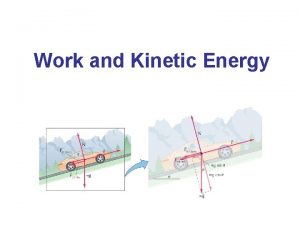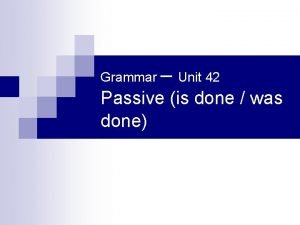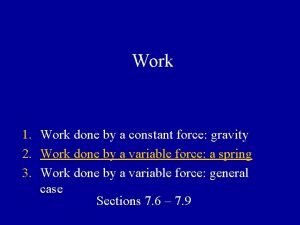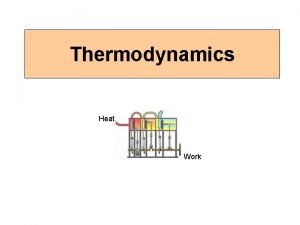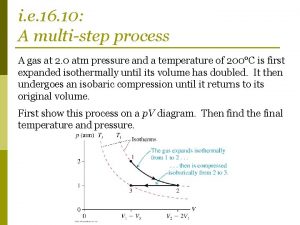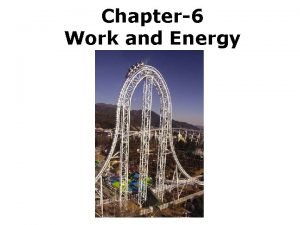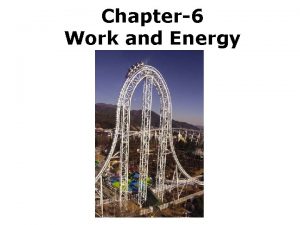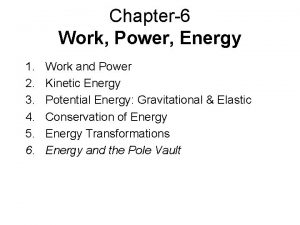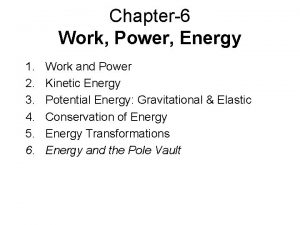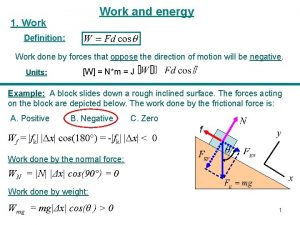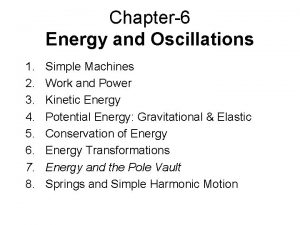Chapter6 Work and Energy 6 1 Work Done











- Slides: 11

Chapter-6 Work and Energy

6. 1. Work Done by a Constant Force Work is done when a force F pushes a car through a displacement s. Work = Force X Distance.

Work The work done on an object by a constant force F is: F = magnitude of the force, s = magnitude of the displacement, and θ = angle between the force and the displacement. SI Unit of Work: joule, J. Work is a scalar.

Units System Force Distance Work SI newton (N) meter (m) N·m = joule (J) CGS dyne cm dyn·cm = erg BE/USC pound (lb) foot (ft) foot·pound (ft·lb)

Bench Pressing During bench-pressing work is done against gravity

6. 2 The Work-energy Theorem and Kinetic Energy

Work-Energy Theorem and Kinetic Energy SI Unit of Kinetic Energy: joule (J)

Downhill Skiing A 58 -kg skier is coasting down a 25° slope. A kinetic frictional force of magnitude 70 -N opposes her motion. Near the top of the slope, the skier’s speed is 3. 6 m/s. Ignoring air resistance, determine the speed vf at a point that is displaced 57 -m downhill.

Downhill Skiing A 58 -kg skier is coasting down a 25° slope. A kinetic frictional force of magnitude 70 -N opposes her motion. Near the top of the slope, the skier’s speed is 3. 6 m/s. Ignoring air resistance, determine the speed vf at a point that is displaced 57 -m downhill.

6. 3 Gravitational Potential Energy The gravitational potential energy PE is the energy that an object of mass m has by virtue of its position relative to the surface of the earth. That position is measured by the height h of the object relative to an arbitrary zero level: SI Unit of Gravitational Potential Energy: joule (J)

A Gymnast on a Trampoline Example 7 A gymnast springs vertically upward from a trampoline. The gymnast leaves the trampoline at a height of 1. 20 m and reaches a maximum height of 4. 80 m before falling back down. All heights are measured with respect to the ground. Ignoring air resistance, determine the initial speed v 0 with which the gymnast leaves the trampoline.
 Work done and kinetic energy
Work done and kinetic energy Was done grammar
Was done grammar Principle of cutter mill
Principle of cutter mill Aldanma cahilin kuru lafına
Aldanma cahilin kuru lafına Chapter 4 work and energy section 1 work and machines
Chapter 4 work and energy section 1 work and machines Energy energy transfer and general energy analysis
Energy energy transfer and general energy analysis Energy energy transfer and general energy analysis
Energy energy transfer and general energy analysis Section 1 work and machines section 2 describing energy
Section 1 work and machines section 2 describing energy Work energy theorem
Work energy theorem The work done by gravity during the descent of a projectile
The work done by gravity during the descent of a projectile Work done pressure volume
Work done pressure volume Isothermal work
Isothermal work
